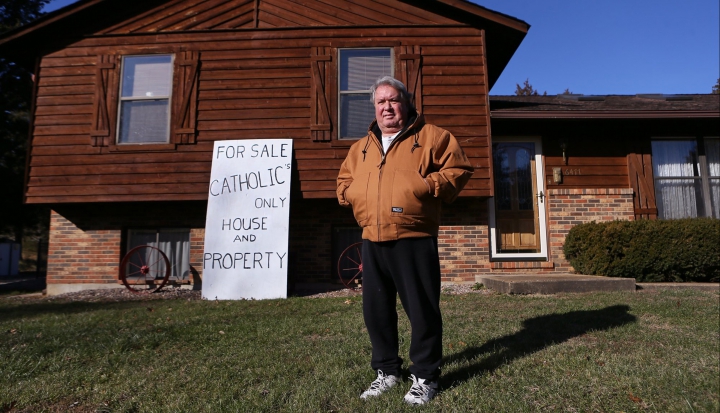c. 2014 St. Louis Post-Dispatch
DITTMER, Mo. (RNS) A quiet street and a quaint three-bedroom home drew Mike Stenzhorn and his family to Dittmer 15 years ago. He and his two children loved the neighborhood in the small community 40 miles southwest of St. Louis.
They didn’t put much thought to the Roman Catholic facility across the street—a small complex of buildings called the Vianney Renewal Center. Stenzhorn knew the center had something to do with helping struggling priests. In any case, it seemed harmless, and the neighborhood was nice. “If you had to live somewhere in the Midwest, and you wanted quiet, this is the place,” Stenzhorn, 62, said one recent afternoon.
But in the years that would follow, the full truth about the Vianney Renewal Center would come to light.
The facility, operated by a Roman Catholic order called the Servants of the Paraclete, cares for religious men who suffer from a variety of illnesses, including alcoholism and depression. The center also treats sexually abusive priests.
The Servants of the Paraclete would not specify how many such priests live at the center today. The Missouri State Highway Patrol’s sex offender registry lists five who are convicted and who stay at the complex under court order. Other priests are sent to the center by various dioceses from around the country. “They’re putting guys there when they don’t know what else to do with them,” said Barbara Dorris of the Survivors Network of those Abused by Priests, an organization founded in 1988.
‘It’s like they were hiding something’
Stenzhorn’s neighbor was among the first to learn the full extent of the center’s operations, in about 2008. “I felt that I was just lied to,” said David Casper, a wallpaper hanger and painter. “Why not let your neighbors, or surrounding people, let them know what’s going on? It’s like they were hiding something.”
Casper immediately thought about property values. “Our fear was that we couldn’t sell it to someone who had children,” Casper said of his home.
So Casper acted—seeking a deal with the Paracletes to sell his house.
In the end he was satisfied with the arrangement. Casper said the center eventually agreed to buy his two-bedroom home for well over what it was appraised for, but he declined to say for exactly how much.
Another neighbor took a similar deal around 2010. But Stenzhorn stuck around.
Stenzhorn said he did not approach the Paracletes for a buyout offer because at the time, he just wasn’t ready to move. Even so, he was concerned about the proximity of pedophiles. The potential threat sometimes made his daughters self-conscious.
“I think it was more when they were younger that it bothered them more. When they were swimming, you know, they were worried,” Stenzhorn said.
But as the years went on, Stenzhorn’s fears subsided. He and even the former neighbors who moved say they never had any issues with the priests living across the street. They describe the clergy members as quiet and respectful.
‘I’ve got some of the worst ones over here’
Father Gerald Fitzgerald founded the Servants of the Paraclete in 1947 in New Mexico. Troubled priests from other states were sent to the Jemez Springs center in the 1960s and 1970s. After treatment, an unknown number of pedophiles were dispatched to serve in New Mexico parishes.
The Archdiocese of Santa Fe was subsequently the target of dozens of sexual abuse lawsuits. In the midst of the lawsuits, the Servants of the Paraclete was forced to shut down its sexual disorders treatment center in Jemez Springs in the 1990s. As a result, several priests were moved to the order’s Dittmer facility.
A decade later, the Paraclete fathers tried to expand their presence here. The order attempted to build a center for troubled priests near Pacific, Missouri, in 2004, but nearby residents who were worried about the safety of their children—as well as their property values—objected.
Later that same year, a former priest from the Vianney Renewal Center, Father William Wiebler, made headlines by moving out of the complex and into an apartment in University City. Wiebler was known to sit on a swing on his flower-filled, second-floor back porch dressed in only a thin robe. Neighbors also spotted him wearing a Santa Claus hat and giving candy to children. Wiebler died in 2006.
“I mean, I’ve got some of the worst ones over here,” Stenzhorn said of the priests. “They all walk the property at night. Not all of them, but probably four or five of them walk out front here.”
In response to questions, a Servants of the Paraclete representative said its policies had been submitted and approved by Praesidium, a professional auditing agency that works with religious organizations to prevent sexual abuse and ensure the best safety guidelines are in place.
After living on Eime Road for 15 years, Stenzhorn hopes to move out of Dittmer and into a smaller home in neighboring Cedar Hill. Although his older daughter still lives at home, she may be moving out soon.
Stenzhorn, who for 35 years drove a beer truck, suffers from severe asthma. He relies on a breathing machine and medication. His condition eventually forced him to take early retirement.
Now that the Vianney Renewal Center owns the houses to the right and left of him, Stenzhorn is completely surrounded by the center’s properties. He said he’s seen the homes used to house visitors as well as elderly priests with health issues.
He wonders whether he should have taken the deal his neighbors took years ago.
Fifteen years ago, his neighborhood wasn’t associated with pedophiles. Few were fully aware of the Vianney center’s operations. And the priest abuse scandal in the Roman Catholic Church had yet to fully erupt. Now he worries about selling the house.
‘I wasn’t looking for a million dollars’
“I mean you got … pedophiles across the street. Who is going to buy the house? A family with kids?” Stenzhorn said.
In fact, Stenzhorn said he hadn’t even tried listing his house. He doubts he could even fetch market rate.
So in April he did what his neighbors did years ago. He approached the Paracletes about the possibility of purchasing his trilevel home, which now boasts a backyard pool.
He was presented with an offer of $175,000. Stenzhorn thinks that price is unfair, especially when compared with his neighbors whose homes, Stenzhorn said, were bought for much more.
County records of such sales are unavailable. Back in 1999, Stenzhorn paid $154,000 for his house. Several years ago, he hired an appraiser who valued the home at $200,000. But based on what his former neighbors said they were able to negotiate, Stenzhorn had hoped for an offer in the $325,000 range.
If “your neighbors got all that money for a house, wouldn’t you feel left out?” Stenzhorn said. “I wasn’t looking for a million dollars. I was looking for what my neighbor got next door.”
(Lilly Fowler writes for the St. Louis Post-Dispatch.)
Image: Mike Stenzhorn, 62, stands on his front lawn in Dittmer, Missouri. He lives directly across the street from the Vianney Renewal Center, a Roman Catholic institution for pedophile priests. Stenzhorn said he posted the sign in front of his house, "to draw attention to the situation." "A devout Catholic that believes in the religion would be more apt to buy it," he added.
Photo by Cristina Fletes-Boutte, courtesy of St. Louis Post-Dispatch












Add comment